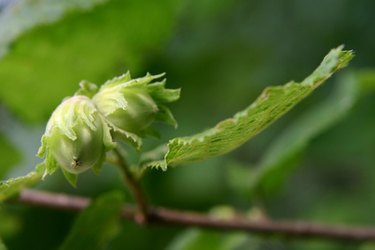
Most people wouldn't think of the Pacific Northwest as a nut production center. But the region does have its surprises, because walnuts do well in many areas and Oregon also produces plenty of hazelnuts. In fact, according to The Hazelnut Council, as of 2008 more than 99 percent of U.S.-grown hazelnuts were grown in the Willamette Valley near Portland. The organization Washington Tilth points out that nut trees work well in multilevel, diversified forest-like plantings that mimic nature, with taller trees forming the upper story, and smaller trees and shrubs as lower levels.
Walnut
Video of the Day
Walnuts need deep, rich, well-drained soil and adequate soil moisture. Thanks to their deep root systems, areas with fairly shallow water tables may be able to grow walnuts with little or no irrigation. The English or Persian walnut, Juglans regia, is grown commercially in Oregon and in small plots or private gardens throughout the region. The late-blooming French cultivar 'Franquette' is the primary commercial variety because kernel color is very light and shells have a tight seal. The crop usually avoids spring frost damage but severe winters can kill trees. Other varieties commonly grown include cold-hardy 'Carpathian' and both 'Chandler' and 'Howard.' Walnut can also be grown for its fine-grained wood; slow-growing, underwatered trees produce the tightest grain. Other possibilities in the walnut family include newer cultivars of the black walnut, J. nigra, and the butternut, J. cinera, which are both very hardy with thin shells and large nutmeats.
Video of the Day
Hazelnut
Some people call them filberts instead of hazelnuts. But either way, as fo 2008, Oregon grows 98 percent of those produced in the United States, according to Oregon State University Extension. In Europe hazelnuts are grown as bushes or small multitrunked trees, but in Oregon most growers train hazelnuts into single-trunked trees that grow to 60 feet tall. The moderate maritime climate zone is ideal for hazelnuts. Interior areas where cherries grow well are also suitable. In hotter areas, hazelnuts benefit from being grown as an understory of larger trees that provide shade and wind protection. Eastern filbert blight, a fungal disease, is now present in both Washington and Oregon, and can seriously injure young trees and cause die back on older trees.
Chestnut
The 1904 chestnut blight marked the beginning of the end for the famed American chestnut, Castanea dentate, which once dominated the forest of eastern North America. Both Chinese chestnut, C. mollisima, and the Japanese chestnut, C. crenata, are reasonably resistant to blight, but not so the European chestnut, C. sativa, currently under assault on its home ground. All of these chestnut species grow throughout the Pacific Northwest, yielding the biggest and best nut crops in areas where peaches thrive. Hybrids of American and Chinese chestnuts are blight-resistant and produce straight trunks as well as large nuts.
Chinquapin
Ideal for a shrub-like understory in many area of the Pacific Northwest is the golden chinquapin or Castanopsis chrysophylla, a native species closely related to chestnuts. Chinquapins are closely related to chestnuts. They can grow to 50 feet and taller in southern parts of their coastal range, but are much reduced in size farther north. Nuts are sweet but small.